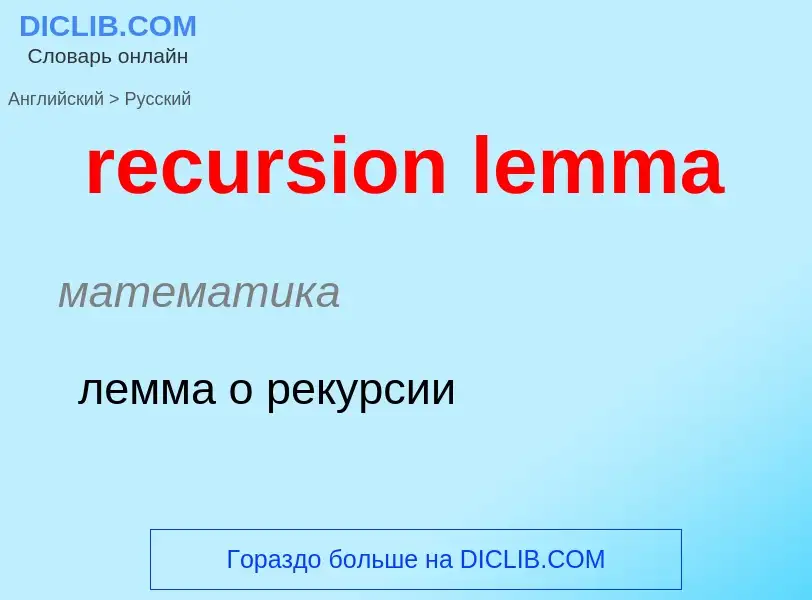Перевод и анализ слов искусственным интеллектом ChatGPT
На этой странице Вы можете получить подробный анализ слова или словосочетания, произведенный с помощью лучшей на сегодняшний день технологии искусственного интеллекта:
- как употребляется слово
- частота употребления
- используется оно чаще в устной или письменной речи
- варианты перевода слова
- примеры употребления (несколько фраз с переводом)
- этимология
recursion lemma - перевод на русский
математика
лемма о рекурсии
[ri'kə:sivnis]
общая лексика
рекурсивность
Смотрите также
существительное
логика
рекурсивность
[ri'kə:ʃ(ə)n]
общая лексика
рекурсия
в программировании - способность подпрограммы или функции вызывать во время исполнения саму себя для выполнения итеративной операции
возвратный
рекуррентный
рекурсивный
антоним
Смотрите также
существительное
математика
рекуррентная формула
рекуррентное соотношение
логика
рекурсия
общая лексика
рекуррентно
рекурсивно
рекурсно
математика
рекурсивная структура
[ri'kə:siv]
общая лексика
рекурсивный
рекуррентный
прилагательное
математика
рекуррентный
рекурсивный
техника
оборотный
способный к повторному использованию
математика
частичное суммирование
математика
суммирование по частям
математика
лемма о пяти гомоморфизмах
Определение
Википедия
Reverse mathematics is a program in mathematical logic that seeks to determine which axioms are required to prove theorems of mathematics. Its defining method can briefly be described as "going backwards from the theorems to the axioms", in contrast to the ordinary mathematical practice of deriving theorems from axioms. It can be conceptualized as sculpting out necessary conditions from sufficient ones.
The reverse mathematics program was foreshadowed by results in set theory such as the classical theorem that the axiom of choice and Zorn's lemma are equivalent over ZF set theory. The goal of reverse mathematics, however, is to study possible axioms of ordinary theorems of mathematics rather than possible axioms for set theory.
Reverse mathematics is usually carried out using subsystems of second-order arithmetic, where many of its definitions and methods are inspired by previous work in constructive analysis and proof theory. The use of second-order arithmetic also allows many techniques from recursion theory to be employed; many results in reverse mathematics have corresponding results in computable analysis. In higher-order reverse mathematics, the focus is on subsystems of higher-order arithmetic, and the associated richer language.
The program was founded by Harvey Friedman (1975, 1976) and brought forward by Steve Simpson. A standard reference for the subject is Simpson (2009), while an introduction for non-specialists is Stillwell (2018). An introduction to higher-order reverse mathematics, and also the founding paper, is Kohlenbach (2005).

![Malyutin]], 1892 Malyutin]], 1892](https://commons.wikimedia.org/wiki/Special:FilePath/First matryoshka museum doll open.jpg?width=200)
![Front face of [[Giotto]]'s ''[[Stefaneschi Triptych]]'', 1320, recursively contains an image of itself (held up by the kneeling figure in the central panel). Front face of [[Giotto]]'s ''[[Stefaneschi Triptych]]'', 1320, recursively contains an image of itself (held up by the kneeling figure in the central panel).](https://commons.wikimedia.org/wiki/Special:FilePath/Polittico stefaneschi, verso.jpg?width=200)
![[[Ouroboros]], an ancient symbol depicting a serpent or dragon eating its own tail. [[Ouroboros]], an ancient symbol depicting a serpent or dragon eating its own tail.](https://commons.wikimedia.org/wiki/Special:FilePath/Serpiente alquimica.jpg?width=200)
![Recently refreshed [[sourdough]], bubbling through [[fermentation]]: the recipe calls for some sourdough left over from the last time the same recipe was made. Recently refreshed [[sourdough]], bubbling through [[fermentation]]: the recipe calls for some sourdough left over from the last time the same recipe was made.](https://commons.wikimedia.org/wiki/Special:FilePath/Sourdough.jpg?width=200)



